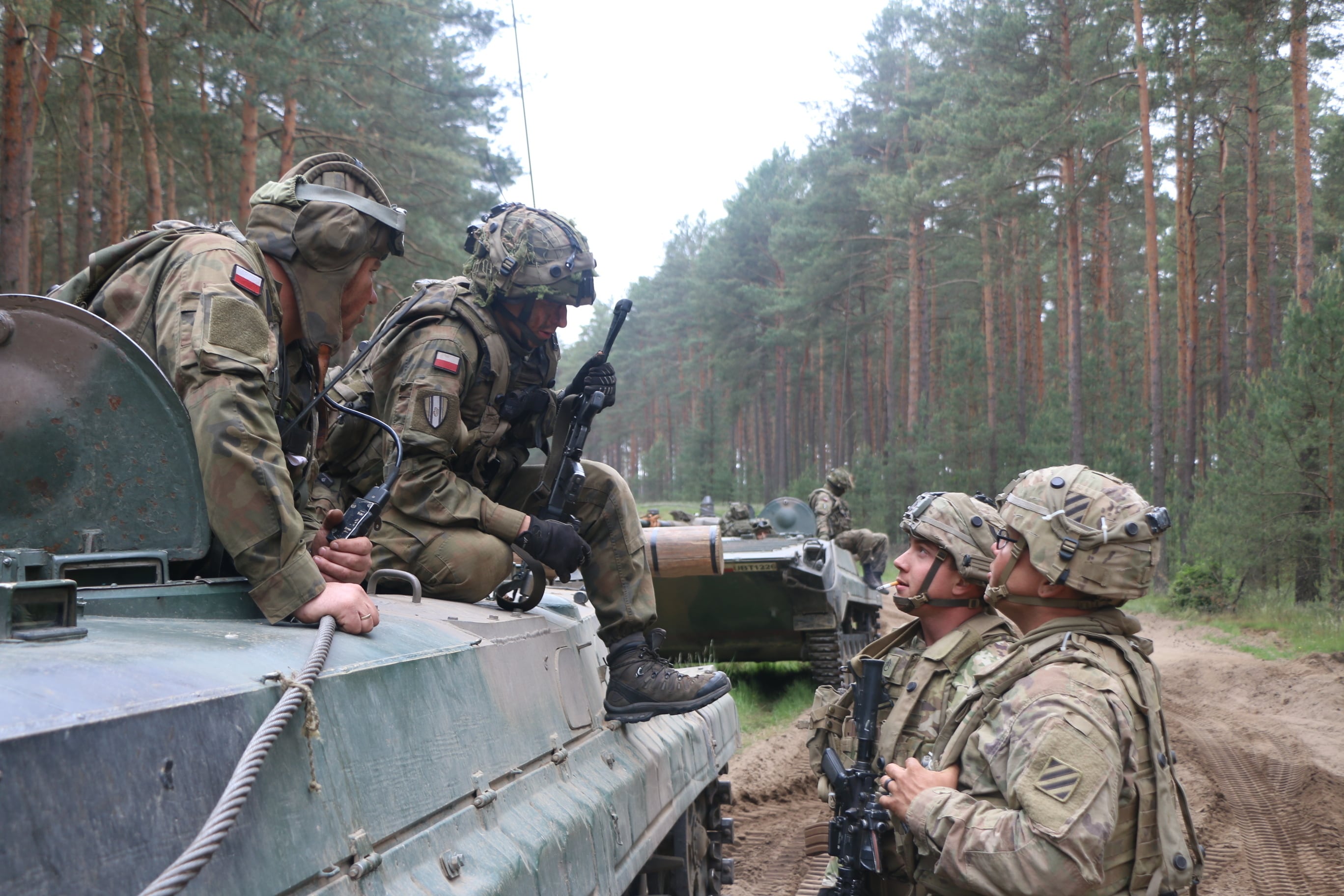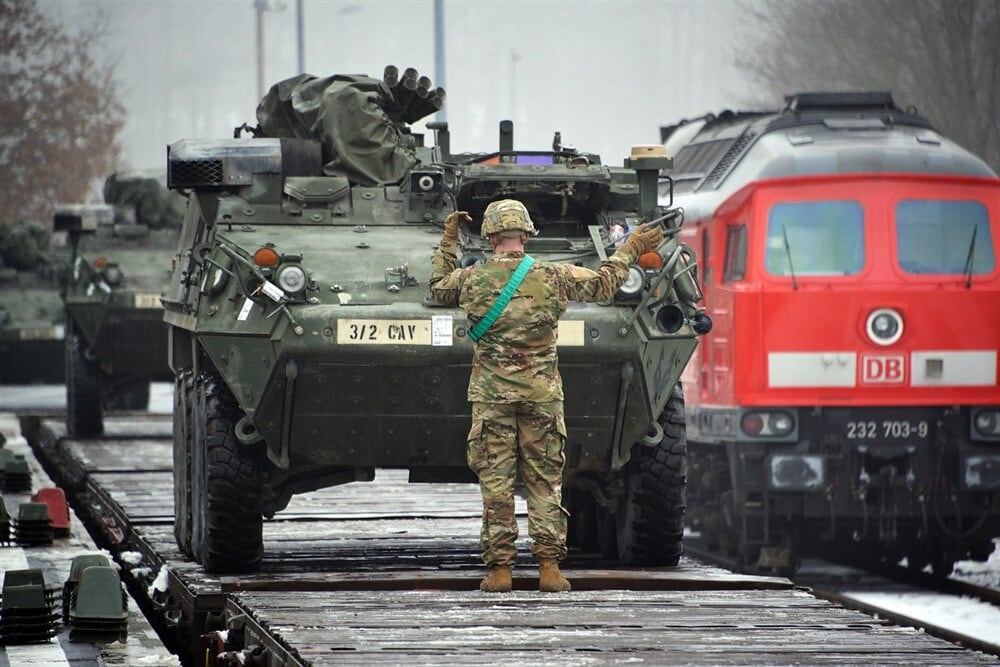On Wednesday, Secretary of Defense Mark Esper conducted a press conference on forward presence in Europe. Vice Chairman of the Joint Chiefs of Staff Gen. John Hyten and U.S. European Command commander Gen. Tod Wolters (by video feed) joined him. This follows on the heels of an announcement in June that the United States would be reducing the number of troops based in Germany. Here are three critical questions and answers regarding these two events:
1. Does the withdraw of U.S. troops from Germany fulfill the “five principles” outlined by the defense secretary in guidance provided to EUCOM following the June 2020 announcement?
A. Enhance deterrence — It is strikingly counterintuitive that a withdrawal of U.S. forward-based forces in Europe coupled with an increase in rotational Army deployments to southeastern Europe would strengthen deterrence. Of course, deterrence is in the eye of the beholder, and there is no certain way to know how Russia will perceive this. However, it is probably obvious to them, as it is to our allies, that when the United States forward stations troops in allied countries — with families — it represents a far stronger, more enduring, even bipartisan commitment to deterrence and a clearer signal of what Washington is willing to shed blood over. This is what our own allies tell us, in private and public. More broadly, given the president’s rhetoric regarding Germany and the fact that all of the announced troop moves involve either removing troops from Germany or cancelling plans to place additional troops in Germany, the United States risks sending the unmistakeable message to Russia that there is a deep cleavage currently existing within the trans-Atlantic community, principally between two of its most powerful members.
RELATED

B. Strengthen NATO — It seems counterintuitive that the announced troop moves would strengthen NATO. It is possible the proposed shift of EUCOM headquarters from Stuttgart to Mons would improve coordination between NATO HQ and EUCOM HQ. Beyond that, though, it appears far more likely that the rebasing of troops — especially the 2nd Stryker Cavalry Regiment currently based in Vilseck, Germany — will weaken interoperability among the allies, as there will be fewer long-term unit partnerships between Europe-based U.S. forces and their European counterparts. Just as the United States experienced in Iraq and Afghanistan when it relied on nine- or 12-month combat rotations, units that have been rotationally deployed to Europe have found that by the time they begin to know and understand the region, their host nation, their host nation counterparts, and the adversary’s operations, their rotation ends and they return to the United States.
C. Reassure allies — During the press conference, U.S. officials spoke about how rotational deployments bolster the American commitment to Europe, reassuring allies. This is inaccurate — in fact, the opposite is true, evidenced by continued Polish, Estonian, Latvian, and Lithuanian lobbying for permanent American presence in their countries, vice rotational. Most rotationally deployed units are sent overseas at rates far below their full unit strength. In my year-long examination of rotational deployments to Europe and Korea, I found that U.S. Army units deployed to Europe at an average of 70 percent of their full strength, leaving behind a sizeable rear detachment. For this reason, fewer troops rotationally deploying more likely means less assurance among allies. Additionally, the move of U.S. air forces from Germany to Italy is being sold as reassuring allies in southeastern Europe, but given the fact that most of Italy is south of Germany and not significantly farther east, the logic of this argumentation is unclear at best. Finally, the announced moves include removing an air defense artillery battalion from Germany and relocating it in Belgium, yet it is similarly unclear how moving air defense capabilities farther from where they are actually needed — i.e., in northeastern Europe, to counter Russian rocket and missile forces in the exclave of Kaliningrad — reassures allies under threat.
D. Improve U.S. strategic flexibility and EUCOM operational flexibility — It is unlikely that returning forces from overseas increases strategic flexibility, since the Defense Department’s own studies show that deploying troops to the Middle East or Europe from the 50 states takes longer and costs more than deploying from Germany, Italy, Spain, and other locations in Europe that are home to U.S. forces. Similarly, it is unclear how having fewer troops at its disposal will improve EUCOM’s operational flexibility. Instead, it will likely decrease flexibility since EUCOM will now have to request forces for exercises, operations, and other activities from the services, vice having them on hand, based in Europe. Moreover, a lack of forward stationed overseas presence reduces military options for any future U.S. president and does not expand them. Instead, moving forces from the 50 states to a location in Europe in the middle of a crisis may appear escalatory and therefore less appealing to any future president.
E. Take care of service members — The announced moves will make the services — principally the U.S. Army — even more dependent on rotational deployments. In my interviews with service members who have experienced these nine-month deployments, I learned that they are quite hard on families and soldiers. Service members on rotation and their families perceive they are being asked to take on many of the same family separation hardships as for a wartime rotation, but without the rewards of a combat patch, tax-free income, or combat pay. Moreover, the training required beforehand usually means the service member is away from his/her family for 12 months, not nine. My study found that this strong anecdotal evidence was reflected in lower reenlistment rates for some rotationally deployed units during the 12 months following their rotations to Europe or South Korea.
2. Will the moves be accomplished cheaply and quickly?
A. This is highly unlikely, given what we know from the 25-year history of U.S. military downsizing in Europe between 1990 and 2015. U.S. officials spoke [yesterday] about costs in the single-digit billions of dollars, but this is likely an underestimate. Significant military construction will be required in the United States, in Belgium, in Italy, and perhaps elsewhere, assuming there is land available for such construction. U.S. officials tried to unite the entire 173rd brigade in Italy some 15 years ago, but ultimately failed to do so because of a lack of available land.
B. Regarding timing, previous efforts to return U.S. force from overseas indicate any moves will take longer than anticipated. For example, in 2005 the United States decided to relocate the 1st Armored Division from Germany, where it had been since 1971, to Texas. It took another six years and $5 billion in construction projects at Fort Bliss before the move was complete. In another example, in April 2005 the United States and Italy announced an agreement to move some battalions of the 173rd brigade from Germany to Italy, to consolidate most of the brigade in one location. The Department of Defense and congressional budgeting and funding processes did not enable construction to start until March 2008. Over five years later, in July 2013, the new infrastructure projects were officially opened, and units began moving.
3. Isn’t it cheaper and more effective to rely on rotational deployments?
A. My year-long examination of rotational vs. forward presence found that the Department of Defense was spending more than was originally anticipated to maintain rotational heel-to-toe presence in Europe and South Korea. In fact, rotational heel-to-toe presence is more expensive than forward stationing in terms of current operating costs — that is, excluding infrastructure investments.
B. In terms of which type of presence results in better combat effectiveness, it is certainly true that rotationally deployed units arrive in Europe or South Korea at a higher level of readiness, and they are able to maintain that readiness throughout their nine- to 10-month deployment thanks to a very high level of activity. However, that advantage is balanced out by two factors. First, forward-stationed units are manned at higher rates — typically 95 percent — than most rotationally deployed units. And second, forward-stationed units typically are more knowledgeable of foreign culture, allied military units, regional geography, and local political leaders.
John R. Deni, Ph.D., is a research professor for Joint, Interagency, Intergovernmental, and Multinational Security Studies at the U.S. Army War College’s Strategic Studies Institute. The views expressed here are those of the author alone and do not necessarily reflect those of the U.S. Government, the Department of Defense, or the U.S. Army.
Editor’s note: This is an Op-Ed and as such, the opinions expressed are those of the author. If you would like to respond, or have an editorial of your own you would like to submit, please contact Military Times managing editor Howard Altman, haltman@militarytimes.com.




